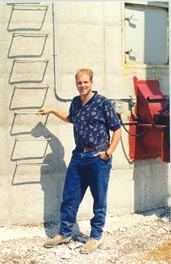
Storing and Drying Grain
Corn growers are constantly looking for ways to cut
costs. According to Andy Timmermans, elevator operators are no different. Grain drying and
handling is a very competitive business and saving a few fractions of a cent per bushel on
drying can make the difference between profit and loss.

Andy recalls that Timmermans Elevators began with two bins, a dryer and a bunch of augers.
Today, the facilities include two dryers and 13 bins, representing half a million bushels
of storage space, along with the associated legs, pits and piping. Recently, it became
apparent that the scale of operation had outgrown the old dryer and they were also able to
get access to natural gas. The time seemed right to upgrade the drying system.
After investigating the options, Timmermans Elevators installed a Zimmerman tower dryer in
1996. Andy was attracted by this type of dryer because its unique design appeared to offer
a number of advantages, including good energy efficiency, cleanliness and reduced noise.
The Zimmerman dryer differs from most others on the market -- the burner and fan are both
located completely inside the dryer. The dryer is top-loading with the drying being done
in the upper portion of the unit. In the lower portion, the dryer uses “negative
cooling” to bring the corn down to the outside air temperature. The fan pulls air
from the outside through the grain column, so that heat from the hot grain is captured and
used to help dry the wet grain above.
Last fall, Timmermans Elevators cooperated with Prof. Ralph Brown from the School of
Engineering at the University of Guelph, to monitor the energy efficiency of the dryer.
The cost of fuel to dry corn from 27.3 per cent moisture was quite satisfactory, at 9.02
cents per bushel. Although the energy efficiency of the Zimmerman dryer was good, it was
not markedly different from that of a number of other common makes and designs of driers
Brown had monitored elsewhere.
Andy was disappointed with the capacity of the dryer. The manufacturer had rated the unit
-- which is 78 feet high and 12 feet in diameter -- as being capable of drying 1,200
bushels of corn per hour (b.p.h.), removing 10 points of moisture (i.e. from 25 per cent
to 15 per cent). In the test done by Brown, however, the capacity was only 690 b.p.h, for
11.8 points of moisture removal.
Operation of the dryer is regulated by a Rolfes computerized moisture controller. Every
few seconds, the controller monitors the moisture content of the grain at both the top and
bottom of the dryer and adjusts the speed of the unloading sweeps accordingly (the dryer
has a flat bottom and is unloaded by four sweep augers).
Andy says that he can’t imagine running a dryer now without a similar moisture
controller. The investment easily pays for itself by eliminating overdrying and the
related costs of wasted fuel and excess shrink. Grain turners halfway down the drying
section also help reduce over-drying of the grain closest to the heat by switching the
grain column inside-out.
Checking the calibration of the moisture controller can be a challenge, however,
especially on a cold, windy day. Under these conditions, Andy has observed that the
moisture content of the grain can vary as much as three points from one side of the dryer
to the other, so there can be quite a bit of variation within the grain from the unloading
auger. The moisture content is usually correct, but a grab sample could be quite different
than the average, depending on where in the grain stream the sample is withdrawn. Andy
doesn’t think the Zimmerman is much different from other dryers in this respect, and
he says calibration is really a job for two people – one to catch the sample and the
other to read the monitor at exactly the same time.
Andy is particulary impressed with the “environmental” features of the Zimmerman
dryer. With the fan being centrifugal and inside the plenum, the dryer is significantly
quieter than other designs. Also, because the cooling air is pulled through the grain, the
area around the elevator is much cleaner than it was when they were using their previous
dryer. Andy does add, however, that they have to clean the cool air chamber daily to
prevent excess accumulation of red dog and other debris.
The simplicity of the system is a plus for Andy. With only one fan and two motors (one for
the fan and one for the unloader), there are fewer moving parts than some other dryers. So
there are fewer things to go wrong and fewer places to check when a problem arises.
Andy also likes the way the quality of the grain is preserved during drying. Because the
corn is in the dryer longer than with other dryers, the temperature changes it undergoes
are not as rapid. That means bushel weight is retained and stress-cracking is not as
severe.
Overall, Andy is pleased with the Zimmerman dryer. He’s not sure how attractive it
would be for general farm use because of the higher capital cost, compared to some of the
alternatives. However, he believes it’s a design worth considering for anyone with a
concern about noise or dust.